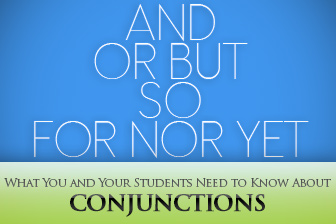Whenever I hear the word conjunction, a song from one of my favorite childhood television programs comes to mind.
“Conjunction junction, what’s your function?” I always loved grammar points set to song, and a surprising number have stuck with me well into adulthood. Perhaps it is because I was always meant to be an English teacher. Perhaps it is my love of music. Regardless, I learned what I needed to know about grammar, and in this case conjunctions, through the music which made it memorable. And while music can make grammar more interesting for some students, the keys to good grammar are the same whether or not they are set to song. The conjunction tune running through my head reminds me that many people have questions about conjunctions. So what is it that your students should know about conjunctions, these small words that mean so much?

Conjunctions: What You and Your Students Need to Know About Them
-
1
What They Do
Coordinating conjunctions, probably the most common conjunctions, are connecting words. They take two or more elements and form a relationship or connection between them. These elements can be words, phrases or clauses, but to use conjunctions correctly all elements in a given list should be the same. (You may be familiar with the term parallel structure, which describes a list of elements with the same syntactic function.) When a conjunction connects individual words, they make a list. And is an additive connector – it expresses a collection of many elements. The car was fast, sleek and beautiful. Or, on the other hand, expresses an alternative relationship – it is one element in the list, not all. Would you like coffee, tea or milk? Use but to express a contrast. He does not eat beef, but he eats poultry. So shows a causal relationship. He did not study, so he failed the test. Other coordinating conjunctions in English include for, nor and yet. All of these conjunctions connect ideas in a sentence, but each has a unique meaning.
-
2
Correct Punctuation
Even native English speakers can struggle with punctuating conjunctions. Whether or not to use a comma is probably the most frequent frustration. When only two words or phrases are joined by a conjunction, no comma is necessary. We are like peas and carrots. When three elements are in the list, however, you must use at least one comma. He likes to ride planes, trains and automobiles. In lists, commas traditionally separate each element from every other one. He ordered an appetizer, a salad, soup and an entree. The bigger the list, the more commas the writer must use. Lists of three or more elements have an optional comma as well. English grammar allows a comma after the penultimate item in the list and before the conjunction when that list contains three or more items. He is taking English, Spanish, and Latin. It is a matter of personal preference whether a writer chooses to include this optional comma. If a writer chooses to use this optional comma though, she must use it consistently throughout the piece she is writing.
When coordinating conjunctions join independent clauses (a clause with a subject and a verb), a comma is required before the conjunction. He passed his driving test, so he got a new car. She will take the bus, or she will ride her bicycle. Even when only two clauses are in the list, the comma is required. Of course, if a writer has multiple clauses in a sentence, he should use a comma to separate each from the others. He went to the mall, he bought a present, and he gave it to his mother. This sentence pattern, though, is not common in English. When a writer joins two dependent clauses (one clause does not contain a subject), however, the traditional comma rule applies. He has a dog and wants a cat. He has a dog, wants a cat and will buy a bird.
Traditional grammar rules state that a writer cannot begin a sentence with a coordinating conjunction. In modern spoken English, however, and increasingly in informal writing, this rule is disregarded. Make sure your ESL students know that in formal situations, standardized tests and academic assignments for example, they should follow the traditional grammatical rules. When they speak, though, they have more freedom in this area.
-
3
Other Conjunctions
Coordinating conjunctions are perhaps the best known conjunctions in English, but they are not the only ones out there. English contains six correlative conjunctions (either…or, not only…but also, neither…nor, both…and, whether…or, just as…so). Coordinating conjunctions show relationships between equal elements in a sentence.
Many subordinating conjunctions also exist. These conjunctions join a dependent clause to an independent clause to form a complex sentence. These include adjective clauses, noun clauses and adverb clauses. Some subordinating conjunctions include that, who, where, whenever and because.
Whether or not you set your grammar lessons to song, and very few of us do, this remains true.
If your students understand these key points regarding conjunctions, they will surely whistle a happy tune on their way out of your class!
Which conjunctions do your students struggle with most?
P.S. If you enjoyed this article, please help spread it by clicking one of those sharing buttons below. And if you are interested in more, you should follow our Facebook page where we share more about creative, non-boring ways to teach English.







